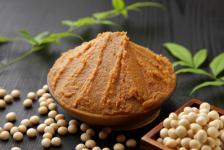Is Miso Good for You?
Find what miso is, how to use it, and how it can benefit your health.


I’ve gotten a handful of questions about miso lately. Francesca writes: “I’ve heard that miso is supposed to be really good for you and could help defy cancer. Is eating more miso the healthy thing to do?” But Katrina wonders whether the relatively high amount of sodium in makes it an unhealthy food choice. Let’s take a closer look at the nutritional pros and cons of miso.
What Is Miso?
Miso is a traditional Asian condiment made by grinding beans and/or grains into a paste, adding salt, and allowing it to ferment. The paste can then be dissolved in water to make a savory broth or used as a seasoning element in sauces and other dishes. Although you can make miso from a variety of different beans, most common types of miso are based on soybeans.
Is Miso a Miracle Cure?
There does seem to be an association between the consumption of soy foods, including miso, and lower rates of breast cancer in Asian women. Western women don’t seem to enjoy the same benefits, possibly because we don’t start eating soy until we’re older. But I’m afraid there’s no credible evidence that miso has any miraculous powers to treat or cure cancer in humans.
See also: Can A Macrobiotic Diet Cure Cancer?
Adding soy foods, including miso, to your diet may confer some protection against heart disease, via a modest effect on cholesterol, and may also help bolster bone health. But miso is not a miracle cure. It’s simply a food—one which has healthful properties but also some potential disadvantages.
Health Benefits of Miso
-
Fermentation deactivates phytates. As I discussed in my episode on the pros and cons of soy foods, one common charge against soybeans is that they contain phytates which can interfere with the absorption of minerals in foods. This isn’t something that’s likely to cause a problem if your diet is reasonably varied and nutritious. (See also: How Important is a Varied Diet?) Nonetheless, one advantage to miso is that the fermentation process deactivates the phytates, effectively eliminating this concern.
-
Miso may contain beneficial bacteria. Fermented foods can also be a source of beneficial bacteria, which have a number of health benefits. But not all miso contains probiotic bacteria. It depends on which combination of micro-organisms are used in the fermentation process. Chinese miso is more likely to contain probiotic bacteria than Japanese miso.
-
Miso contains soy isoflavones. Isoflavones are the active compounds that are responsible for most of soy’s purported effects and miso will contribute to your isoflavone intake. However, bear in mind that the amount of isoflavones in a serving of miso is relatively low. You’d get 4 to 5 times more isoflavones (and protein) from a serving of tofu, soymilk, or edamame than you would from miso.
-
Quick and Dirty Tip: Red or brown miso contains more soy and therefore will have more isoflavones than white or yellow miso.
https://www.ars.usda.gov/SP2UserFiles/Place/12354500/Data/isoflav/Isoflav_R2.pdf
Disadvantages of Miso
-
High sodium content. As listener Katrina pointed out, miso is rather high in sodium. A tablespoon of miso, which is enough to make about one cup of miso soup, contains about 600mg of sodium, or about a quarter of your daily allowance. If you’re trying to watch your sodium intake, that might be a concern. There are some low-sodium miso products available.
-
Soy is a common allergen. Soy allergies are triggered by certain proteins in the beans. The fermentation process breaks down proteins and carbohydrates in soy and makes them more digestible. This process can even reduce the level of allergenic proteins. But if you’re allergic to soy, miso can still provoke a reaction. Some people claim that fermentation renders soy safe even for those with allergies but I wouldn’t recommend it.
How and Where to Buy Miso
If your grocery store has a big gourmet or international foods department, they may carry miso paste. If not, do an internet search to locate your closest Asian grocery. Miso comes in lots of varieties, ranging in color from off-white to dark brown, depending on what type of beans and grains are used and how long it is fermented. The lighter colors tend to be milder in flavor. You can also buy dehydrated miso powder that can be reconstituted into miso soup—although don’t expect as much in terms of flavor—or beneficial bacteria.
How to Use Miso
Dissolve a tablespoon of miso in a cup of boiling water for a satisfying, low-calorie broth. Add seaweed, mushrooms, and/or cubed tofu for a traditional miso soup. I also use miso as a seasoning. Try whisking a small amount into salad dressings, sauces, and marinades to add complexity and depth of flavor. Just remember to adjust the amount of salt accordingly.
See also: How to Make the Perfect Vinaigrette
Keep in Touch
Do you have a favorite way to enjoy miso? Post it in the comments section below. You can also post comments and questions on my Nutrition Diva Facebook Page. I answer a lot of listener questions in my free weekly newsletter, so if you’ve sent a question my way, be sure you’re signed up to receive that.
Have a great week and remember to eat something good for me!
Miso Paste and Miso Soup images from Shutterstock

 Fermentation deactivates phytates. As I discussed in my episode on
Fermentation deactivates phytates. As I discussed in my episode on 
